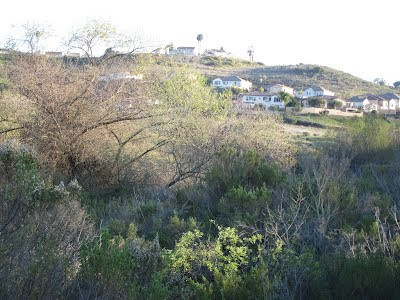Sometimes, the best hikes are just out your front door. Eager to get in a hike and let the dogs off leash before the sun set, we went on a "discovery" hike of our neighborhood, venturing into the "No Trespassing" field behind our house where several radio towers are located. Since I'd seen several neighbors with their dogs hiking there before, I knew not to take the prohibitive sign too seriously. Armed with the dogs and my camera, we sought to identify some local flora and fauna right in our neighborhood. The hike was about 2-3 miles and lasted about 90 minutes. Below are the pictures I took.
--A locust, sunbathing on the sidewalk.
I spotted this locust on the way to the radio towers (the unofficial name we've dubbed this hike). These guys can form huge swarms, destroying crops and agriculture in epic, plague-like proportions. In the Jewish religion, locusts are one of the plagues that occurs during the history of the holiday, Passover, which is celebrated around Easter.
Links:
--view of the field where we took our hike, surrounded by houses.
Surprisingly, even though the field where we hiked was surrounded by residential neighborhoods, we discovered many species native to chaparral found in southern California. In addition, as is common in residential areas, a lot of non-native species could be found at the bottom of the valley, where run-off accumulates, forming a man-made creek. Run-off is one of the big problems threatening our native chaparral. For instance, run-off contributes to erosion, accumulation of water-soluble pollutants, such as pesticides, and encouraging growth of non-native species, such as reeds, and other swamp-loving plants, normally not found in chaparral. These non-native species can take over and become invasive, choking out real estate for native chaparral plants.
Links on Run-Off:
Not only does sage smell wonderful, but, interestingly, some religions advocate the burning of sage around your home to ward off negative energy and evil spirits. Remember though, leave only footsteps when you go hiking. It only hurts our environment more if you take plants and other species home with you.
Links on the Ceremonial Uses of Sage:
http://powayusd.sdcoe.k12.ca.us/projects/kumeyaay/PDF/PlantCards/WhiteSage.PDFhttp://voices.yahoo.com/tips-using-white-sage-smudge-sticks-cleanse-1308755.html?cat=30
--Juneau, our Lesser San Diego Black Dog, frolicking on the path.
--gopher hole, one of many, littering the field.
These guys can be pests for both farmers, residents, and chaparral alike. Solution? San Diego Black Dog (shown above). Juneau's natural prey includes gophers. On the plus side, at least they provide nourishment for coyotes, owls, hawks, and other birds of prey, all which are native fauna to southern California.
--cactus, of the genus Opuntia, or "prickly pear".
http://suite101.com/article/coastal-prickly-pear-cactus-a75122
http://www.desertusa.com/magoct97/oct_pear.html
http://en.wikipedia.org/wiki/Cactus_Wren
--close-up of cactus, Opuntia
--Stink Beetle (Eleodes gigantea)
http://www.projectnoah.org/spottings/11325265
http://www.kpbs.org/news/2012/nov/29/invasive-beetle-devouring-san-diegos-oak-trees/
There are over 200 different species that belong to this genus. They all produce a seasonal fruit, after which the plant is named. There are many medicinal, cultural, and food uses for this cactus, a beloved and important plant to peoples of Mexico and Native American tribes. Some birds, native to southern California, like the cactus wren, actually nest within the protective spines of the prickly pear, safe from predators beneath the formidable spines.
Links about Opuntia cactus:
http://en.wikipedia.org/wiki/Opuntiahttp://suite101.com/article/coastal-prickly-pear-cactus-a75122
http://www.desertusa.com/magoct97/oct_pear.html
http://en.wikipedia.org/wiki/Cactus_Wren
--close-up of cactus, Opuntia
Interestingly, legend has it that wherever you see a prickly pear growing in southern California today, you are actually witnessing a remnant from ancient Native American tribes that lived here centuries ago. After enjoying the fruit, the Native Americans would spit the seeds out as they foraged, camped, and lived off the land. In that spot, a cactus grows, historically marking the site where Native Americans used to live. Next time you spot one of these cacti, look for flat rocks, tools, and even arrowheads leftover from where the Native Americans used to call home.
Links:
San Diego Cactus and Succulent Society
--flowering yellow plant, "Deerweed", "California broom", or "broom lotus".
This plant is part of the pea family and native to California chaparral. Scientific name: Lotus scoparius. This plant flowers between March and August. Polllinators, like hummingbirds and bees love it.
Links:
This guy is a type of darkling beetle. He sticks his butt in the air as a warning if you come close, letting you know that he does not smell good. They can appear in large numbers during hot, dry periods. They move quite slowly, often spotted ambling in the dirt or sand. Beetles are helpful for the environment, feeding on dead things and other detritus. They help decompose organic matter, returning it to the earth. Not all beetles are helpful, however. The goldspotted oak borer beetle is responsible for destroying and endangering the oak trees in the Cleveland National Forest.
Links:
http://swellbugs.blogspot.com/2011/04/eleodes-gigantea.htmlhttp://www.projectnoah.org/spottings/11325265
http://www.kpbs.org/news/2012/nov/29/invasive-beetle-devouring-san-diegos-oak-trees/





No comments:
Post a Comment